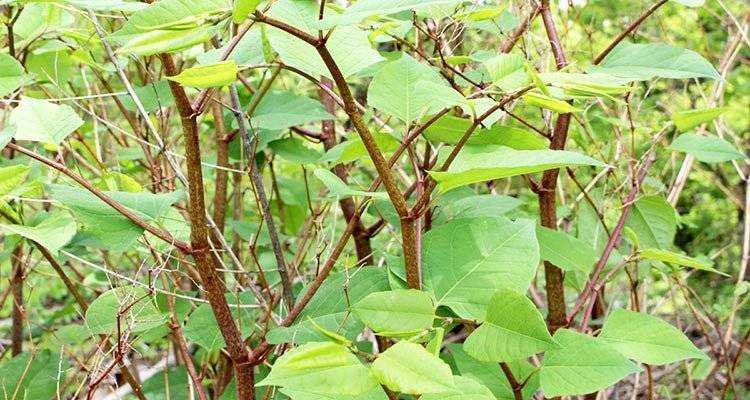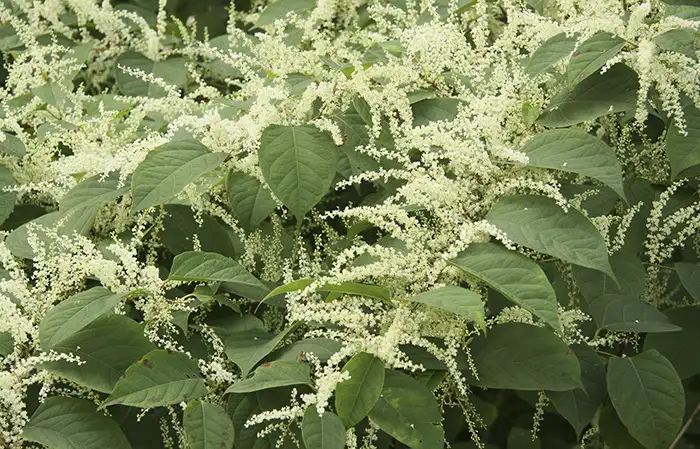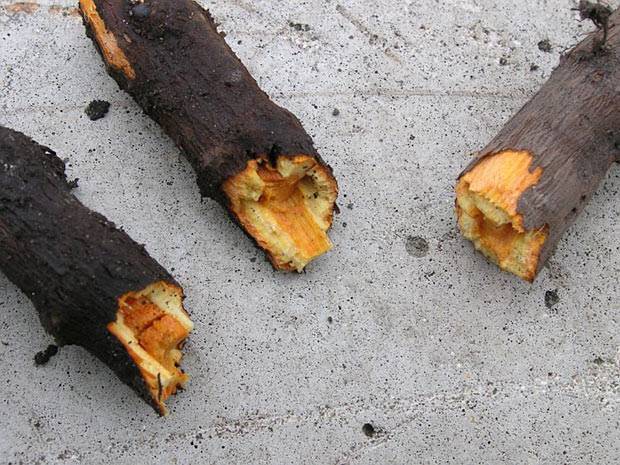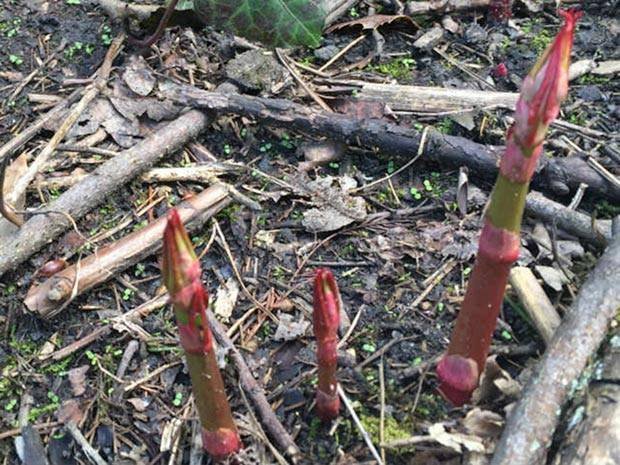Beautiful Plants For Your Interior
Japanese Knotweed Removal

Japanese Knotweed and Japanese Knotweed removal is a hot topic for many gardeners in the UK.
Japanese knotweed (Reynoutria japonica/Fallopia japonica) are weeds that spread very rapidly. The Environment Agency has called Japanese knotweed, “indisputably the UK’s most aggressive, destructive and invasive plant.” This weed is so powerful that it can cause structural damage to homes or buildings.
In winter the plant dies back to ground level but in early summer, bamboo-like stems emerge from rhizomes deep below and shoot up to well over 7ft – (2.1m), suppressing all other plant growth nearby with its presence.
It can grow taller than any human can reach by hand and is very difficult to remove using chemical means of eradication. New legislation now covers control methods for this invasive species.
Philip von Siebold was a German physician, botanist and traveller, who was responsible for sparking an environmental disaster by bringing Japanese knotweed to the UK in 1850.
His introduction of this invasive weed (originally introduced to Britain as an ornamental garden plant) was met with widespread interest from society’s wealthy at the time, who were eager to cultivate it and share their knowledge of botany with others as a pastime.
As the years went by though, those same enthusiasts found that they would have never guessed at how much harm one small plant could do when left unchecked.
So What is Japanese Knotweed
Japanese knotweed is a tall, strong, fast-growing, dense perennial that can grow up to 9.8ft (3m) high. It has slender deep penetrating creeping underground stems called rhizomes.
Japanese knotweed is an invasive, non-native species (in the UK) and it can be controlled by a few methods. Let’s look at the methods of control in this post and the government legislation now in place to cover its control.

Japanese Knotweed Removal: Creamy White Clustered Panicles And Heart Shaped Leaves of Japanese Knotweed
How to Identify Japanese Knotweed
- Japanese Knotweed Flowers – These are creamy white 0.5cm wide flowers that form clustered panicles that can grow to 10cm. They bloom in late summer (August/September) usually when all else has started to wither.
- Japanese Knotweed Height – As mentioned already, Japanese knotweed can grow to around 9.8ft (3m) high.
- Japanese Knotweed Leaves and Stems – Have a very unique look, due to the heart-shaped or shovel-shaped leaves and pointed tips, that shoot out from hollow nodes/stems in a peculiar ‘zigzag’ pattern. They can possibly grow 3/4in (2cm) a day. New Japanese Knotweed leaves are ‘usually’ rolled up and have dark, purple/red veins, while mature leaves can grow up to 8in (20cm) long and are green in colour with purple/red veins.
- Japanese Knotweed Roots (Rhizomes) – Japanese Knotweed is a deceptively dangerous weed, as it can grow to cover large areas of ground. It has roots that are dark brown on the outside and orange/yellow inside. The plant can grow up to 3 metres deep and 2-7 meters horizontally depending on soil and weather conditions. Japanese Knotweed roots will usually have diameters between 3/4 – 8in (2 – 20cm) in diameter.
- Japanese Knotweed Growth Rate – Japanese Knotweed is known for its fast growth rate. The growth rate during its peak of late spring /early summer is staggering; it can grow up to 4in (10cm) per day.
- Japanese Knotweed Seeds – Japanese Knotweed is the bane of many a gardener. The heart-shaped seeds, which are barely visible to human eyes and feature small wings, however, they almost never germinate naturally. Generally, new plants tend to grow from nodes or pieces of green stem in soil or water.

Japanese Knotweed Removal – Roots of The Japanese Knotweed, These Spread Very Rapidly.
Be Sure of Your Identification
Japanese knotweed can often be mistaken for other plants, like Fallopia baldschuanica (Russian vine) Leycesteria formosa (Himalayan honeysuckle) Houttuynia cordata (Fish Mint) and Persicaria microcephala (P. microcephala ‘Red Dragon’) so sometimes it can be difficult to identify correctly.
It should also not be confused with a less troublesome form of Japanese knotweed that is grown in gardens, namely Fallopia japonica var. compacta and its cultivars, which is the dwarf variety of the plant, that is much smaller in stature.

Japanese Knotweed Can be Identified by Its Sprouting Pale Red Buds
Those looking to identify invasive non-UK species of plants including Japanese Knotweed can see the GB Non-native Species Secretariat (NNSS) identification sheets for more information.
Japanese Knotweed Removal – Japanese Knotweed Identification Video Guide
We Know We Have a Problem!
If you have identified that indeed you have Japanese Knotweed, removal is probably your next course of action. But beware, read the following paragraphs before you proceed further and decide on your next course of action.
For example; under the provisions made within Schedule 9 of the Wildlife and Countryside Act 1981, it is an offence to cause Japanese knotweed to grow in the wild and it’s illegal to cause it to spread by careless removal and dumping.
Therefore any such actions of Fly-tipping should be reported to The Environment Agency, free-phone number 0800 807060.
Japanese Knotweed – Buying or Selling a Property (Legal Speak)
As we have discovered Japanese knotweed (Fallopia japonica) is an invasive species in the United Kingdom. In 2013, property sellers were required to state whether Japanese Knotweed (fallopia Japonica) could be found on their property.
This is communicated through a TA6 form or the old Property Information Questionnaire (PIQ) used for conveyancing.
This form will also include information about any other issues that may pose potential problems if they are not dealt with before selling your house.
Your solicitor or conveyancer should provide full legal advice about this.
Selling a Property
As the seller, you are responsible for checking your property to find out about ‘Japanese Knotweed’ before you sell. The TA6 form asks you if it is ‘growing’ on your property, where it is growing, and what steps you have taken to provide a management plan from a professional company in order to eradicate the plant.
Buying a Property
If you are buying property, the presence of Japanese Knotweed will be stated in the responses on the TA6 form.
If Japanese Knotweed is indeed present, this may often result in your mortgage lender requiring assurances that it will be eradicated before agreeing to the funds.
This process is often agreed upon between the seller and the buyer with an ‘approved’ management plan by a professional company for the controlled removal and eradication of the species. In addition, the lender will also possibly require a transferable guarantee to that effect.
This is usually sufficient for the lenders as it makes them feel better about providing funds, as Japanese Knotweed can cause major property damage if not dealt with properly and professionally.

Japanese Knotweed Removal – A survey by Professionals is Always Advised.
Buyer or Seller It Is Worth Checking Out
If you’re a buyer or seller and want to avoid any potential problems down the line, it’s worth checking for Japanese knotweed.
Just be proactive, if disputes arise about the possibility of Japanese Knotweed on the property, failure to disclose their presence in advance may trigger ‘increased ‘costs’ later in the process – that’s not what anyone wants!
In addition, if someone claims that there was a misrepresentation, these issues could be costly and stressful long after a sale is complete. So make sure you take this pre-emptive step so all parties can enjoy a trouble-free sale.
Contact: The Royal Institute of Chartered Surveyors for survey information on Japanese Knotweed.
Search – ‘Japanese Knotweed’
Updated Legislation
In a recent amendment to the Anti-Social Behaviour, Crime and Policing Act 2014, invasive non-native plants like Japanese knotweed are included in the amendment. Here’s what this means for property owners:
- Japanese knotweed is a non-native invasive plant that can cause damage to your communities. Fortunately, it’s not illegal to have Japanese Knotweed in your garden if you control the growth of this invasive species on your property and keep it from growing in other areas where your local communities live.
If unchecked though, having Japanese Knotweed that could affect other people’s quality of life with persistent or continuing problems, then the legislation could be used to enforce its control and property owners may be prosecuted.
- If you have a neighbouring garden that is having problems with Japanese Knotweed, why not speak or correspond directly with them first? Who knows, they may well be taking action already. This will help matters before you make more of an issue of it and it could save time in contacting the council to discuss action under the legislation.
- Homeowners can consider controlling for themselves a small, isolated clump. However, it is strongly recommended a specialist professional company with the necessary skills and control to ensure eradication and that dispose of these invasive plants at the licenced landfill site in your area.
Control of Japanese Knotweed
The RHS believes that by using good cultivation methods and introducing natural enemies, pests can be controlled without the use of chemicals (Cultural Control Methods).
However, if a serious threat does arise to our wider environment or important specimens, they recommend only minimal chemical control in targeted areas where necessary.
Japanese Knotweed And Cultural Control Methods
When it comes to Japanese knotweed, some of the recommended cultural controls don’t provide a long-term solution.
- If you don’t hire a professional to remove Japanese knotweed, it creates problems when trying to dispose of the plants. The Environmental Protection Act 1990 classifies this invasive species as “controlled waste,” meaning disposal has to be done at licensed landfill sites. Alternatively, it can be destroyed on-site by allowing it to dry before burning.
- Specialist Japanese Knotweed contractors must be registered with the waste management department to safely remove this type of plant from your property. But first, it’s important for you to do a quick check on their registration before hiring them for removal services. On no account should Japanese Knotweed be included with normal household waste or put out in green waste collection schemes.
Can You Control It With Weedkiller?
Japanese knotweed is a very tough weed to eradicate without professional help. The amount of time it takes depends on the size at to what extent the plant has grown.
It could take anything up to 3 or 4 seasons to remove them. Property owners who want Japanese Knotweed gone as quickly as possible should engage professionals with access to stronger, more regulated chemicals that can possibly reduce this time frame by half.
If undertaking yourself, always follow the safety instructions with regards to personal protection and in particular about how much product you need when using these powerful weedkillers, so you do not run into the risks of harming other plants, humans (children in particular) or pets.
- The most effective and simplistic way to kill Japanese knotweed on your property is with a glyphosate-based weedkiller, such as Roundup Tree Stump Weed Killer. This has label recommendations for difficult plants like this one – instructing it be applied either after cutting or through foliar spraying. SBM Job Done Tough Weedkiller (soluble sachet) also has labels recommending control of Japanese Knotweed.
- Glyphosate-treated knotweed can come back in the form of small-leaved, bushy regrowth that is often 20in-36in (50 – 90 cm) high. This does not look like your typical plant and it must be treated as soon as possible to avoid another full growth!
- It should be noted that if you try and treat knotweed yourself, you will not get an insurance-backed guarantee without using a professional company for Japanese knotweed control. This may not seem like an important decision now, but it will come back to haunt you if or when selling your property or having any legal battles with neighbours caused by this invasive weed becomes front and centre in any actions.
- If you use glyphosate weedkillers you should take care to avoid leaves and or other green parts of all your garden plants as it is not selective in its action. Used with care though, glyphosate is safe to use around the base of non-suckering woody plants, as long as the bark is woody, brown and mature.
It can be noted that Glyphosate is not active in the soil and there is, therefore, no risk that garden plants will absorb it through their roots.
The inclusion of weedkiller products in this post does not indicate a recommendation or endorsement by Garden Junkie or any of its authors. It is simply an indication of products currently available to the home gardener.
Japanese Knotweed Removal – Get professional help from the Property Care Association (PCA)
Professional Help is at Hand
Professional companies are equipped to deal with Japanese knotweed removal. They can report on risk for mortgage purposes, and provide the property owners with a treatment plan, as well as insurance-backed guarantees in cases where such guarantees are required by lenders.
The Royal Institution of Chartered Surveyors (RICS) has worked with the Property Care Association (PCA) to establish the PCA Invasive Weed Control Group (IWCG) trade body for Japanese knotweed specialists, which provides a register of vetted consultants and contractors.
For further information property owners can also contact:
Invasive Non-native Specialists Association (INNSA) maintains an updated membership list of contractors and consultants phone 0800 1300 485.
The British Association of Landscape Industries (BALI) has a good directory of members offering invasive weed control.
Trustmark Government Endorsed Standards also has a ‘Find a Tradesman’ scheme including invasive weed controllers.
FAQ’s
Can Japanese Knotweed Grow Back After Removal?
Yes, Japanese Knotweed can grow back after removal if any small fragments of the plant are left behind. It is important to ensure that all plant material is completely removed and disposed of properly to prevent regrowth.
Can Japanese Knotweed be Burned or Composted?
No, Japanese Knotweed cannot be burned or composted as it can spread easily through any fragments of the plant. It must be disposed of properly at a licensed waste facility.
How Much Does Japanese Knotweed Removal Cost?
The cost of Japanese Knotweed removal can vary drastically depending on the severity of the infestation and the location of the plant. On average, the cost can range from £2,500 to £5,000 for a small infestation and up to £20,000 or more for a larger infestation. It is recommended to obtain a quote from a reputable Japanese Knotweed removal specialist to get an accurate cost estimate.
Conclusion
As you can see, Japanese Knotweed is one of the most difficult invasive plant species to remove effectively. It has been declared an invasive species in the UK and carries hefty fines for those who are found guilty of not managing it properly on their property.
If you have any questions or concerns about your own situation with Japanese Knotweed, we encourage you to contact the professionals. They offer professional help that includes guarantee-based services so you never need to worry about whether you might be penalised for leaving behind some remnants of this plant during removal.
Contact them today if you want reliable information and expert guidance when it comes to providing efficient Japanese Knotweed removal once and for all!
Finally, you can always pop over to our FAQ page to find out more about Japanese Knotweed removal and a whole host of other answers to your gardening questions and queries.
